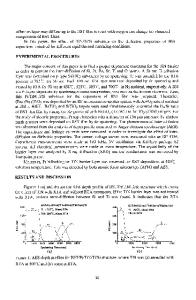Effect of annealing on fluorescence of Ce 3+ -doped silica prepared by sol-gel process
- PDF / 102,840 Bytes
- 4 Pages / 612 x 792 pts (letter) Page_size
- 23 Downloads / 287 Views
We prepared Ce3+-doped silica by the sol-gel method and studied the effect of annealing on fluorescence of these samples. Different fluorescence was observed for samples annealed at different temperatures, changing gradually from solution like fluorescence to fluorescence similar to that observed in the Ce3+-doped silica prepared by chemical vapor deposition. It was found that the emission intensity first decreased with increasing annealing temperature until 500 °C, and then increased with the temperature ranging from 500 to 950 °C. Meanwhile, the emission peak showed a large red shift and an obvious broadening. These changes were attributed to the annealing-induced structural evolution in silica: Ce3+ ions changed from coordinating with water and terminal OH-groups to embedding in silica network.
I. INTRODUCTION
Silica glasses doped with rare-earth ions in trivalent states (RE3+ ions) are important materials with applications including solid-state lasers, optical wave-guides, and fiber amplifiers.1 Recently, the sol-gel process was adopted to prepare such materials. This process is of current technological interest due to the liquid chemical synthesis of homogeneous materials at relatively low temperatures. At the same time, it suffers from some limitations. First, the sol-gel process results in a porous final product. Second, aggregation of RE3+ ions resulting from their low solubility in pure silica degrades emission efficiency.2,3 Third, and most important, the radiative transitions of RE3+ ions doped in sol-gel silica are quenched, due to coupling with vibrations of the matrix, in particular, with OH− groups.4,5 It has been shown that the content of OH− groups and the porosity in sol-gel silica can be greatly reduced through controlled heat treatment.6,7 Among RE3+ ions, a cerium (Ce3+) ion acts as a most sensitive probe ion because the fluorescence from Ce3+ ions originates from 5d–4f transition, and the 5d state is easily affected by the outer crystal field.8,9 Because of these characteristics, we chose Ce3+ ions to study the change of local environment in silica with annealing. In this paper, we prepared the Ce3+-doped silica by the sol-gel process and studied the effect of annealing in reducing atmosphere on fluorescence of these samples. II. EXPERIMENTAL
All samples were synthesized by the sol-gel procedure, as previously reported.10 The mixture solution of tetraethyl orthosilicate, ethanol, and deionized water (molar 2364
http://journals.cambridge.org
J. Mater. Res., Vol. 15, No. 11, Nov 2000 Downloaded: 05 Apr 2015
ratio, 1:4:15) was stirred and catalyzed by HCl until pH ≈ 2. Then an appropriate amount of CeCl3 aqueous solution was introduced into the mixture solution during stirring of the solution. The molar ratio of Si to Ce in this solution was controlled to be 100:1. This solution was poured into many containers, sealed, and held at 50 °C for 5 days to gelate, and then aged and dried at up to 110 °C for about one week. After drying for such a long time, almost all residual water and alcohol wer
Data Loading...










